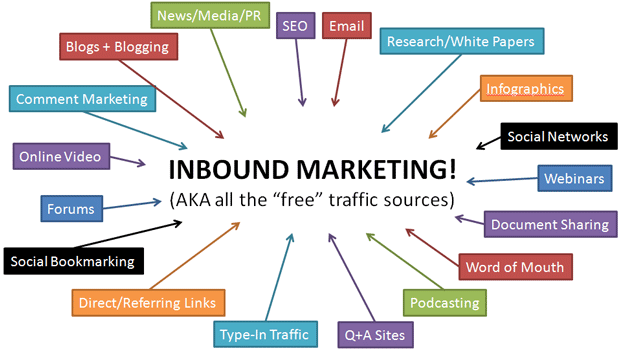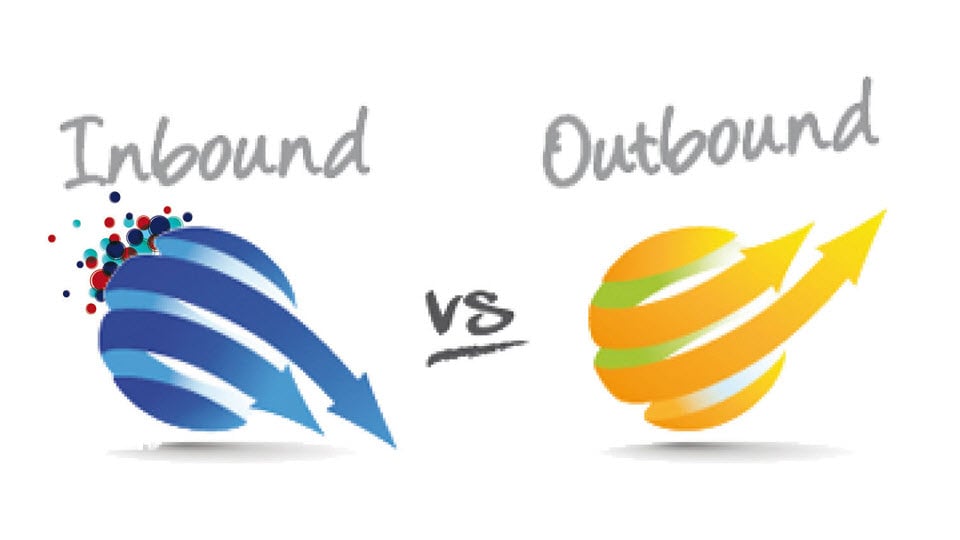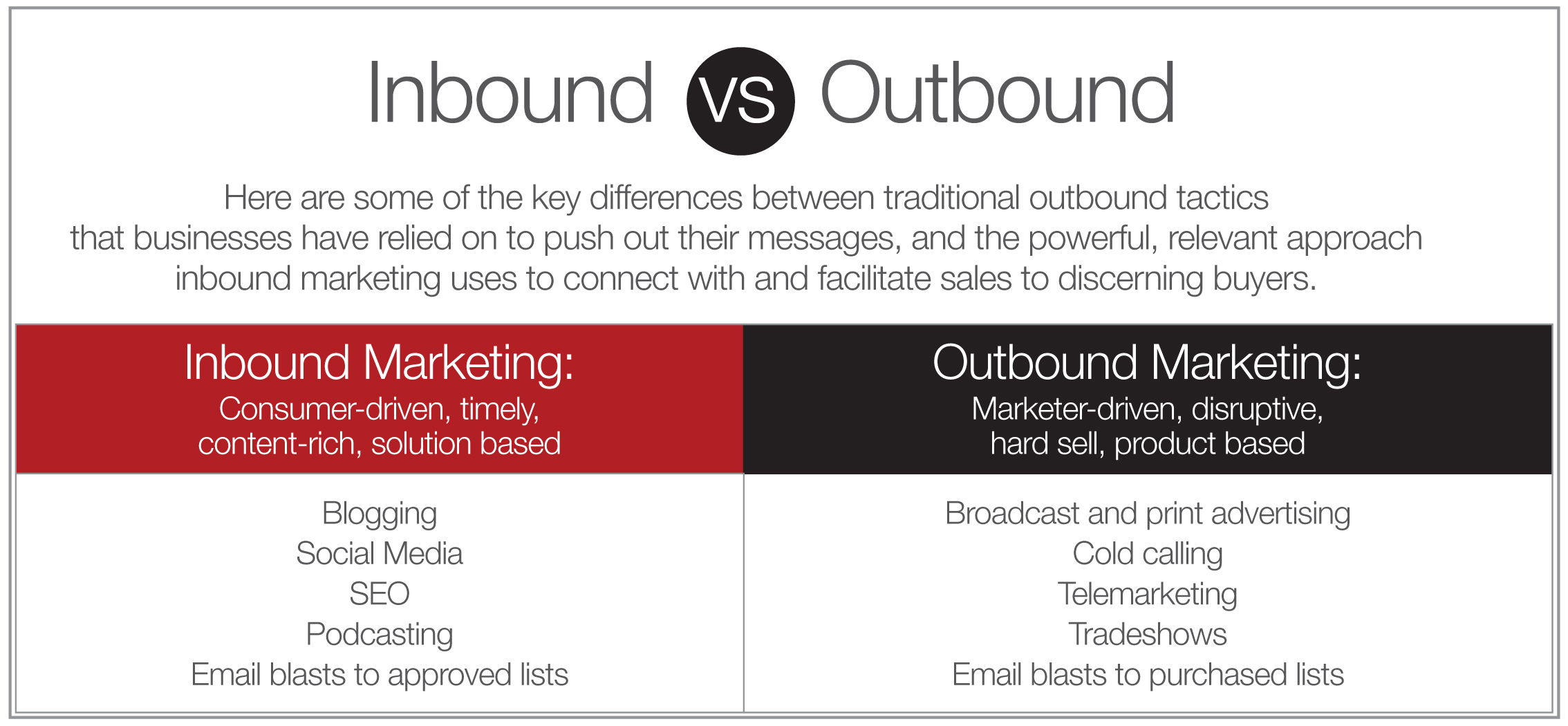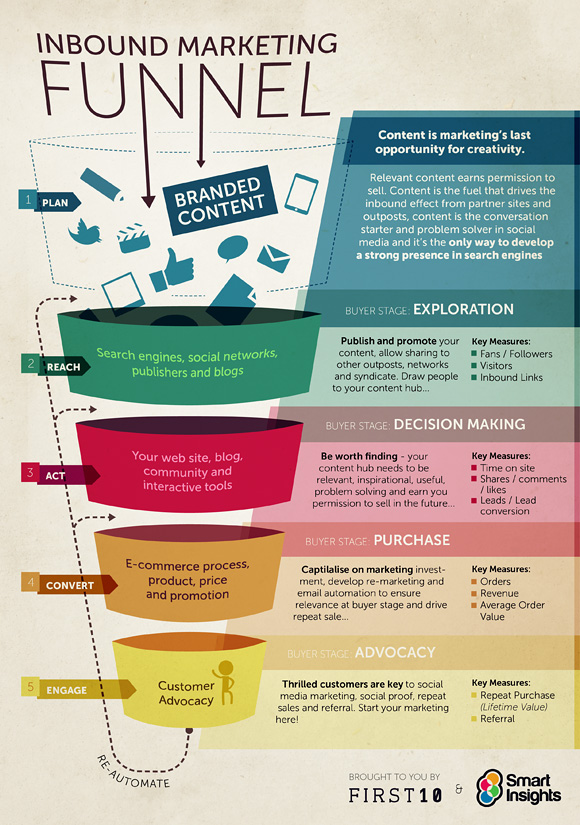
In today’s modern times, inbound marketing is increasingly becoming a force to be reckoned with. The old-school way of outbound marketing is getting a serious run for its money. You can primarily thank the Internet for this change in the marketing landscape over the last several years.
One of the easiest ways to understand the key difference between inbound and outbound marketing is looking at their respective approaches.
Essentially, inbound marketing relies on earning as opposed to buying a person’s attention. In sharp contrast, outbound marketing, today sometimes referred to as interruption marketing with good reason, relies on pushing products and services on consumers in an effort to buy their attention.

Ideal examples of the former are blogs, white papers, social media and podcasts while notorious examples of the latter are TV, radio and prints ads, banner advertising and cold calling.
Today’s B2B buyer behavior has changed. He is a new entity altogether: more well-informed, more research-minded and hungrier than ever for information about the solutions your B2B company can offer him. As such, today’s new B2B buyer is in love with inbound marketing because he consults B2B websites, blogs, newsletters and white papers more than ever before to help his company make a buying decision.
In this context, let’s take a look at how the B2B buyer behavior has changed in just the last several years.
Inbound Marketing: A Closer Look
Inbound marketing is characterized by several important features. First, it’s basically a two-way dialogue between vendors and buyers. Second, it’s executed via the creation of interesting content that adds nothing but value and provides information to buyers.
This establishes a favorable response from the buyers, which in turn leads to a greater likelihood of them buying your products or services. Finally, inbound marketing is exemplified by content like blogs, infographics, vlogs, podcasts, eBooks, social media and white papers.

There are a lot of benefits to inbound marketing, which explains why it is on the rise whereas outbound marketing is on the decline. According to HubSpot, proof of the many benefits of this type of marketing includes statistics like:
- 57% of businesses have snagged buyers thanks to their company blogs
- 42% of businesses have obtained buyers by way of Twitter
- 57% of businesses have gotten buyers from LinkedIn
- 48% of businesses have found buyers from Facebook
Pardot lists three additional benefits of inbound marketing that you should be aware of:
- It helps your B2B company get found by being discovered on Google searches
- It allows you to create long-term relationships with your buyers
- It empowers you to find higher-quality leads that will go farther into the sales cycle
Outbound Marketing: A Closer Look
Outbound marketing is falling out of favor so fast that you could say that it is the red-headed stepchild of the marketing world, especially where the new B2B buyer behavior is concerned. You can easily identify outbound marketing. In fact, any time you’ve ever seen a TV, print or radio ad, you’ve been subjected to this type of marketing. Other examples include cold calling, direct mail and telemarketing.
It has been derogated as a one-way dialogue with buyers because a company’s products and services are being pushed onto the consumer via intrusive ads. As such, it offers people barely any added value. Another reason outbound marketing also fails to bring real value is because it rarely ever wants to inform or entertain its targets.

While some resources still claim that there are benefits to outbound marketing, many are instead focusing on the numerous disadvantages of outbound marketing. HubSpot has identified at least two major problems with outbound marketing:
- The average person is getting more skillful at blocking out marketing interruptions
- The cost of inbound marketing is simply cheaper
Meanwhile, the Houston Chronicle outlines further problems with outbound marketing. They include:
- Most of your outbound-marketing audience actually has no interest in your products or services
- The few who are interested in your outbound-marketing efforts need to be exposed to your messaging many times over before they act on it
The Industry Trends on Inbound and Outbound Marketing
The key takeaway is that inbound marketing is here to stay, according to HubSpot’s 2013 State of Inbound Marketing Annual Report.
Essentially, if you’re not doing inbound marketing, then you’re totally missing the boat and falling behind this fast-growing trend. 58% of all marketers are now doing inbound while just 23% aren’t; another 19% are undecided on this, but you can bet that they’ll eventually gravitate to inbound marketing as well.
The same annual report also reveals that the results are better when inbound marketing is performed compared to when outbound marketing is performed. Of the companies surveyed in the annual report, 34% said that their leads came from inbound marketing, but only a paltry 22% said that their leads came from outbound marketing.
It must also be pointed out that inbound creates both a better quality and greater quantity of leads compared to outbound.

Furthermore, inbound marketing also lowers costs. Survey respondents in the annual report we mentioned earlier said that they spent just $36 per inbound lead versus $41 per outbound lead. They also reported that they spent just $254 for the average cost per customer from inbound marketing, but they spent $268 for the average cost per customer from outbound marketing.
This new way of marketing brings successful results to companies, so it should be no surprise that more and more of the company budget is allocated to inbound. The annual report revealed that 49% of all surveyed companies increased their inbound marketing budget in 2013 from their 2012 levels.
Finally, ROI is an extremely vital measure of a marketing approach since it demonstrates the effectiveness of the strategy. Inbound marketing didn’t disappoint in that regard. According to the same annual report, 41% of marketers said that inbound marketing demonstrated ROI for their companies while only 9% said it failed to do so.
A Word on Cold Calling
Cold calling falls squarely into the outbound-marketing category, and it has been reviled by many in the marketing world as falling out of favor fast. Clearly, inbound marketing has played a huge role in cold calling’s decline in popularity.

Studies have also shown that cold calling is not a successful way of marketing, at least not anymore, which certainly explains its increasing rejection by marketers. A recent study from Baylor University’s Keller Research Center showed that:
- 72% of cold calls tracked in the study were met with rejection
- Only 28% of the cold calls in the study were deemed productive
- The rate of cold calls to appointments in the study totaled a pathetic 0.03%
In spite of these grave statistics about cold calling, Software Advice reported in a recent survey still reported that B2B companies said that cold calling was their third-highest, quality lead-generating channel.So while cold calling is struggling and not as effective as it once was, it is not yet dead.
How Decision Makers Do Research
Decision makers at today’s B2B companies are the epitome of the new B2B buyers who use the Internet to perform research into products and services in which their companies are interested.
Instead of waiting for advertisers to find them, almost 100% of all B2B decision makers are now boldly becoming spectators more than ever. This means they read blogs, watch value-providing videos and still listen to podcasts. Again, this is a confirmation of inbound marketing’s power and influence.
In addition, B2B decision makers are addicted to social media. There’s no question that the majority of them are using social media, but the key is determining what percentage of those who use social media use it for actual business purposes and what percentage simply use it for personal reasons.

According to a Forrester study, 85% of B2B decision makers will visit generic forums and communities on a monthly basis, yet just 18% of this activity is primarily for business. Of those who visit LinkedIn, just 26% do so for primary business purposes while only 2% of those visiting Facebook do so for primary business reasons.
Of course, it’s also important not to lose sight of just how important mobile is to B2B decision makers during the buying process. Decision makers who use mobile to research products and services make up 57% of all executives. Think that’s a significant statistic? Get a load of this: 38% of all decision makers actually make the final decisions to buy products or services right from their mobile phones.
Clearly, B2B decision makers are using inbound marketing like crazy to conduct research for products and services their companies want to buy. This encompasses everything from blogs and videos to social media. Since executives are busy people, it’s also no surprise that mobile plays a big role in the research stage of the buying process as well.
Inbound Marketing Enabled by a Killer Website: A Fundamental Part of the Puzzle
Here is the most important takeaway from all this: Inbound marketing has taken the marketing world by storm in only several years’ time, and the new B2B buyer is a huge fan of inbound. However, inbound or outbound marketing without the benefit of having a killer website to back up your marketing efforts is useless.
Think of it this way: Your killer website is what ties all of your marketing efforts together. Let’s say that you’ve moved, along with many in the marketing world, to inbound as your primary way of promoting your products and services.
Each time the new B2B buyer does a Google search and clicks on your site in the search results to read your blog or download your white paper, you want a killer website that empowers him to find the solutions to his business problems very easily.

The same is even true if you’re still part of the true believers who still spend time and money on outbound-marketing tactics like cold calling.
Let’s say that you obtain leads from cold calling; those leads inevitably end up on your website where your landing page is. If your website has abysmal site navigation that leads to a horribly poor user experience, you can kiss your sale goodbye since the friction in the buying process increases.
So no matter what marketing tactic you’re using, you are best served if you have a killer website that features stellar navigation and functionality. You’re simply not going to sell as much if your website is dreadful. After all, the new B2B buyer just wants a very thoughtful website to navigate through. It’s that cut and dry, that plain and simple.
These days, buyers want a site that helps them find exactly what they are looking for to solve their problems in a very easy way. Give this to your buyers, and your B2B company is going to prosper for a long time to come.
Conclusion
The new B2B buyer is someone who is engaged, informed, cautious and vigilant. He is an avid user of inbound marketing, which includes everything from your blog and social media to anything of value that he’s looking for. He may be a decision maker, or he may be part of a team whose sole purpose is to use Internet tools and technology to research solutions for problems at his company or organization.
This means that outbound marketing doesn’t interest him all that much because he’s more proactive than ever. While old-school tactics like cold calling still have their place among certain marketers, inbound marketing is really rising while outbound marketing is falling. That’s the industry trend.

But to stay on top of this—no matter if your leads are being generated from inbound or outbound marketing—you have to have a killer website, period. Your website is the face of your company and brand, so having a sub-par one will reflect badly on your brand, products and services.
So don’t underestimate what it takes to design a killer website, and make sure that it is low-friction, easy to navigate and gives the new B2B buyer exactly what he’s looking for.
Hey—that’s what the buyer wants.








